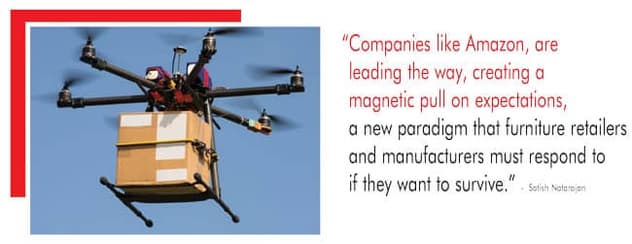
Let’s take a moment to talk about some of the most exciting and fast moving changes that are likely to impact our industry.
You might imagine that the best new growth opportunities for furniture retailers will come from new celebrity licensing opportunities from the likes of Joanna Gaines, The Property Brothers, Ellen DeGeneres, or Trisha Yearwood. Or, perhaps that entertainment marketing, leading edge advertising and experiential store design will lead the way.
In this article, however, we will make a case that some of the most exciting opportunities for furniture retailers will be in the areas of transportation and logistics. It’s where rubber meets the road in terms of potential cost savings, sales increases and customer satisfaction; an area that will reveal innovative new ideas and technology introductions accelerating over the next five to ten years.
Furniture World spoke with a number of industry experts to get their views on the present and future of furniture delivery, first mile to last. The second installment in this series will look at how technologies such as self driving trucks, delivery robotics and other new technologies and ideas will change how our industry sells and delivers furniture. First, we asked our experts to explain what retailers can and should focus on right now to meet and exceed customer expectations for delivery speed, transparency and professionalism.
Customer Expectations
“Companies like Amazon,” observes Satish Natarajan, CEO at DispatchTrack, a software provider to the furniture industry delivering next-gen route optimization and field management software, “are leading the way in creating a new level of expectations, a new paradigm that furniture retailers and manufacturers must respond to in order to stay competitive.”
Natarajan notes, “Customers expect better service. We find that the biggest disappointment occurs when a home furnishings consumer receives a damaged product. So, damage-free delivery is the number one customer expectation. The second expectation is on-demand, on-time and faster delivery. In this day and age, given similar product quality, consumers don’t hesitate to buy an item that can be delivered the soonest.
“To make this happen, retailers need support from manufacturers so that they can provide better service and faster delivery,” observes Natarajan. “On the manufacturing side, winners will be the ones whose supply chains can deliver products faster. That’s why supply chain restructuring is happening today, creating just-in-time demand, and just-in-time manufacturing. Big retailers are investing time and money in their own organizations to become more efficient, faster, and predictable.”

Delivery Improvement
Furniture World asked Natarajan about strategies retailers can use to bring technological solutions to real world problems. He suggests that they start by looking within their own organizations. “A good place to start," he says, "is to assemble a group within your organization that will identify a limited, manageable number of factors that need improvement, and come up with one or two tangible ways to improve. Often such improvement can be obtained at minimal cost by deploying inexpensive solutions such as tracking technology, taking photos with cell phones, and basic organizational improvements. This enables managers to focus on one or two action items they can accomplish in a short time frame and move their delivery operations in the right direction.
Rob Davis, Vice President of Client Solutions at Diakon Logistics agrees, “It is time for retailers to dig in a little bit, take the time to meet with their teams and look at technology solutions providers to get an education regarding all the functionality that’s available now or will be coming online soon.
“My view,” he says, “is that if a retailer’s delivery operation hasn't changed in the last six months, to a year, there have been missed opportunities. Retailers need to look at how long it takes to analyze, process and take action on their data. Is it a minute, an hour, a day or a full week? There are certain decisions that require a month or two worth of data, and others that require just an hour’s worth of data. If a delivery team is running two hours late, retailers need to know instantly, because if they don’t realize until the next day that 50 percent of their deliveries were late, it doesn't really do much good.”
“Improvement always starts with measurement,” Natarajan summarizes, “because what isn’t measured, can’t be improved. The important metrics to measure are damage-free deliveries, on-time deliveries and overall customer satisfaction.”
“When retailers receive negative feedback from their customers, it is usually a symptom of a bigger problem related to not being organized. Instead of focusing on just fixing issues in a reactive way as the occur, it would be beneficial to take a step back and think about processes that may be flawed or outdated. It may turn out that a delivery system needs to be revised, or attention needs to be paid to general delays in product arrival that routinely bubble up and cause dissatisfaction."
"The takeaway,” he concludes, “is for retailers to focus improvement on a limited number of metrics, such as speed and meeting customer expectations."
Supply Chain Visibility
"Your Supply Chain is only as good as its weakest link, Natarajan says. He therefore believes,
“Manufacturers should invest in bringing visibility of product movement within supply chain all the way up to the customer. Without this visibility, the retailer is held accountable on any delays.
“Therefore, for retailers today it’s not enough to just buy the best products at the best price. “As well,” he suggests, “they need to choose partners who will be able to provide supply chain visibility in order to be able to set the retail customer’s expectations clearly.
“For example, let's say a retailer initially tells a customer that her furniture will be delivered in few weeks, but the product gets delayed by four additional weeks. If there is timely communication about this issue, the customer is kept in the loop all along the way, and the delivery is ultimately made at a time convenient to the customer, the overall experience becomes smoother for both the customer and the retailer. Fortunately our industry now has the tools that can address this problem.”

“Tools are readily available for everyone to see what’s going on with their deliveries down to the last mile delivery,” adds Diakon's Rob Davis. “Retailers should be on this like hawks, but I think the industry is lagging in figuring out how to respond to the data they have. Consumers increasingly demand to know what’s going on with their deliveries. Providing them with updates along the way is just as important as showing up on time. They really appreciate knowing the status. However, the medium is changing and most customers want to receive relevant details and options via texts or alerts instead of phone calls.”
Retailers that fail to meet customer expectations do so at their own peril but it is possible to minimize the damage, Natarajan tells us. “If customers have problems and you make it right, you won’t get kudos, but they will still buy from you again, and won't talk about it over social media. There are two main reasons a retailers’ delivery operations get mentioned in a social media setting. The first is to not satisfy customers with corrective action when something goes wrong. The second is when retailers exceed customers' expectations by going above and beyond to correct problems.
Deluxe Or Not To Deluxe
“Seven years ago,” recalls Peter Ross, the Director of Transportation for the retailer Z Gallerie, and president of the International Furniture Transportation and Logistics Council, “I stopped deluxing furniture. Bit by bit I believe retailers are going to get away from it for two reasons. First, consumers love to receive products in a box. Second, 96 percent of the time there's nothing wrong with delivered furniture. If I have to pay a claim once in a while then that’s fine.
“Regarding home furnishings delivery he says, “It’s all about perception and the customer’s mood when they buy it.
"Packaging can always be better, so if we find a carton that's wet or compromised, that's when we open it up and look at it. It’s my experience that third parties love the idea of getting paid 10 bucks just to open a box. And quite frankly perception is not something that we want a nine-dollar an hour guy judging. So at Z Gallerie we look for brokenness, not for vendor defects where a customer might or might not accept it.
Patrick Cory, CEO at Cory Home Delivery believes that what may be good for Z Gallerie, is not the best solution for all furniture retailers. “There are retailers who choose to live with higher returns as opposed to incurring the cost of having people open and inspect each box. A lot of it has to do with a store’s return policy. And a lot has to do with customer expectations that result from the way products are presented to the customer at the point of sale. If a retailer is selling a premium service, with a liberal return policy," he observes, "then it’s best to open and inspect. If they are telling customers they will receive their delivery in a box, and if there’s damage, to let them know, that’s another story. It really is a cost versus benefit analysis for each retailer. Generally higher end retailers open and inspect. Lower end retailers tend not to.
Reverse Logistics Challenge
“Let’s talk about what I call the Amazon effect,” Cory continues. “The Amazon effect is really changing the way consumers perceive how products should be delivered to their homes.
"Based on their experience with Amazon and other internet companies, consumers have come to expect that any product they order is going to come in a box, and that it will be delivered in close to perfect condition. They also expect that if it’s not perfect, it can be easily returned. And this is the case if the customer orders an iPhone, a television, or most appliances. These are all mass produced of metal, plastic and glass, boxed in a way that very little is going to happen to them when shipped.
"When we deliver a TV there’s a high likelihood that it will be delivered in perfect condition with no quality issues. That’s not true of furniture. Furniture, has blemishes, it’s fragile, and it often gets damaged in shipment. There are no packaging standards. Much of the product that comes from overseas has poor packaging and there are defects.
“Internet companies have a deliver it in a box mentality. But the product and packaging for furniture hasn’t kept up to support that. The product hasn’t gotten significantly better to allow it to be opened by consumers and be assembled by that consumer without problems. Frankly a lot of internet companies are struggling with this perception right now because it’s one thing to deliver mass produced products. It's another to deliver furniture. The result is that consumers are put in a position where they have to carry a big box to their apartment or room in their home, unbox, assemble, and move it around all without causing damage. When it works, it works. And when it doesn’t work there’s a need for what’s called reverse logistics. It's a problem right now that is costing internet companies customers and money. They don’t know what to do when a product doesn’t fit, doesn’t work, or is damaged. Currently, most of them don’t want to take it back. And if they do, they throw it in the garbage. So, there's a struggle with reverse logistics. When something happens, customers want somebody to fix or replace it. That part of the supply chain for internet retailers is still a big question mark.

Diakon’s Rob Davis agrees that online retailers are struggling with reverse logistics. “Furniture does not like to be moved. The more times it's handled, the greater the likelihood of damage by the time it reaches the customer. Even for the new online mattresses retailers, such as The Tuft and Needle and Casper have had to find creative ways to deal with the problem of returns.
They ship rolled up mattresses to customers via a carrier service. It’s a smart delivery model until it gets to the customer’s home, is unrolled and becomes a full size queen mattress. At that point if a customer doesn't like it or it's damaged, they don’t have an efficient way to get it back. The solution for them is to donate the mattress locally and not even deal with the reverse logistics.
“And so, it comes down to this debate.” Patrick Cory says, “Should internet retailers deluxe or not deluxe? Lots of internet retailers offer free threshold delivery where the box is left at the customer’s door without opening it. Or they leave it just inside the home. Or, they have what’s called room of choice, where it gets dropped in the room of choice. And some do offer full white glove deluxing and assembly services. They still have a problem with reverse logistics, but in my opinion, inspection of the product prior to delivery, even if it needs to be re-boxed in the original box, is a better option. That’s because it reduces returns, damages, credits, and exchanges.”
Amazon And Wayfair
Cory believes that there are new delivery strategies on the horizon. “Right now most of our industry is doing furniture delivery the old-fashioned way,” he observes. "Our products are being handled by six or seven different companies. But a new model is going to streamline the process to allow faster delivery and better visibility for consumers. Even, more important, it’s going to allow retailers of all sizes to compete with the Amazons and Wayfairs of this world.
"Change is being driven by companies like Sam’s Club, Wal-Mart, Target, Wayfair, and Costco. They are still going through growing pains to provide consistent service at the end of the delivery process, with returns and exchanges. They are at the very beginning stages."
It's given that most brick and mortar retailers cannot stand still in the face of aggressive competition from these internet giants. Patrick Cory believes that the number one mistake brick and mortar retailers make is to try to sell and deliver product online using a brick & mortar model. "The second biggest mistake that companies make," he tells us, "right now, is they try to compete with Wayfair and Amazon by trying to sell their products outside of their current trading areas. They’re not ready for that yet. The supply chain isn’t ready for that yet.

“Right now, there’s no reason for regional retailers to sell everywhere in the country. Why would a regional chain based in Florida want to sell a $399 recliner in Chicago at a loss to compete with Wayfair? Why would they want to reach out to a shopper who has never been to one of their stores, who will likely get poor delivery then go on Yelp to complain about horrible service? Why would they want to sell a $299 dinette in rural Illinois that ends up being exchanged?”
He says, “What these regional players do need to do is to have a robust internet presence so that they can effectively sell online inside of their current trading markets. They already have the inventory and infrastructure to sell and service properly. They need to give shoppers the ability to buy items they may have seen in a retailer's store, in an ad, or online, at their convenience. These furniture retailers already have the supply chain, the warehouse operation, inventory and service infrastructure to handle any problems.
“Retailers, right now, are running scared, but they don’t have to. They have a competitive advantage, which is local service. Local retailers have the ability to tell customers, even if they order online and they never walk into the store, that any problems with delivery can be resolved quickly and efficiently. Online retailers do not have that part of the customer service equation figured out. So, brick and mortar retailers should sell to the fact that they have immediate delivery. Sell to the fact that they can provide service in the home, and sell to the fact that they have white glove services provided on a local branded truck.
Next Issue
In the next issue of Furniture World we will look at the future of home furnishings delivery with a discussion of commingled models, smart trucks, robotics, augmented reality and innovative pricing models for furniture delivery.
Russell Bienenstock is Editor-in-Chief of Furniture World Magazine, founded 1870. Comments can be directed to him at editor@furninfo.com.